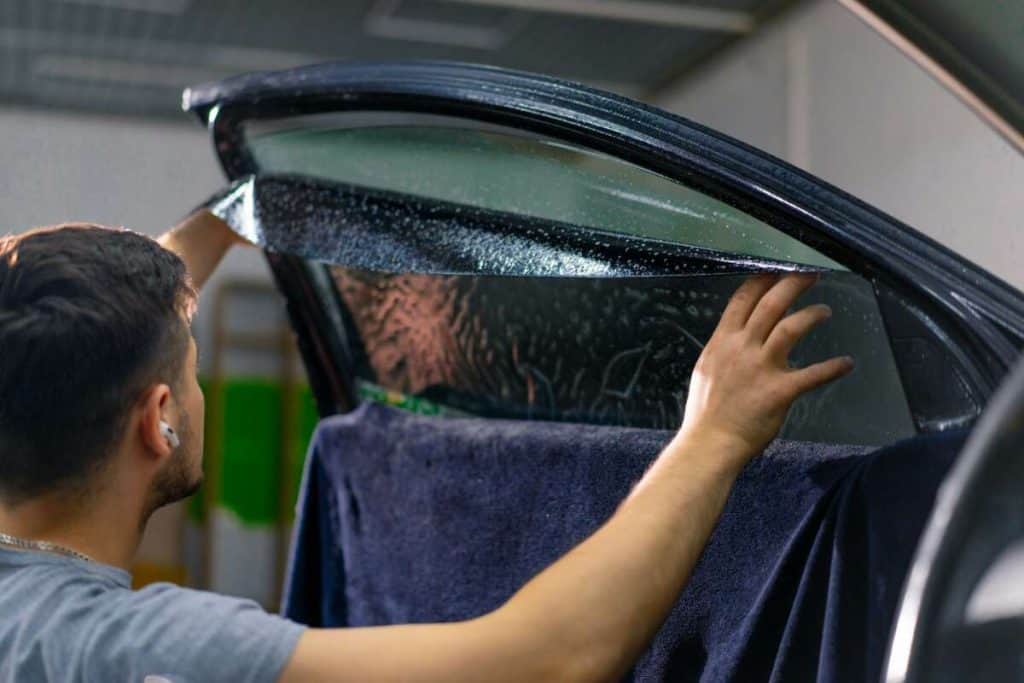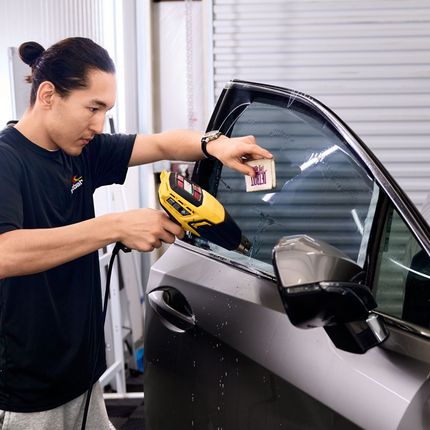A Complete Guide on Window Film Solutions by Davinci of Michigan
Wiki Article
A Comprehensive Overview to Understanding Car Window Tint and Its Benefits
Automobile window tinting offers even more than just an aesthetic function for automobiles. It supplies various types, each with unique functions and advantages. Understanding these alternatives, together with legal guidelines and maintenance pointers, is important for any type of lorry proprietor. The benefits may substantially improve driving convenience and vehicle long life. As one explores the subtleties of window tinting, the inquiry develops: what type of tint is finest suited for specific needs?Recognizing Car Home Window Tint: What It Is and Exactly how It Functions
Auto window color acts as a safety barrier that enhances lorry aesthetics while offering practical benefits. This thin film is put on the indoor surface of automobile home windows, minimizing glare and blocking dangerous ultraviolet (UV) rays from the sunlight. By filtering sunshine, car home window color aids to regulate the interior temperature level of the lorry, leading to enhanced convenience for guests and reduced reliance on air conditioning.Additionally, it safeguards the automobile's inside from fading, maintaining both furniture and control panel materials. The tint can also improve personal privacy, making it a lot more difficult for outsiders to see inside the automobile. Certain types of window tint can raise security; in the event of a mishap, the movie assists hold destroyed glass with each other, minimizing the risk of injury from flying fragments. On the whole, vehicle window tint offers both visual and functional objectives, making it a popular option amongst lorry proprietors.Kinds Of Home Window Color: An Overview of Options
When thinking about home window color choices, a number of kinds are readily available, each with distinctive qualities. Colored, metalized, and ceramic home window colors supply varying degrees of heat rejection, UV defense, and aesthetic appeal. Comprehending these distinctions can aid automobile owners make informed selections based on their preferences and needs.Colored Home Window Color
Dyed home window tint represents a popular selection among automobile owners looking for a inexpensive and efficient method to improve their car's aesthetic appeals and privacy. This kind of color is developed by putting a layer of color between a protective finish and an adhesive layer, causing a darkened look that decreases glow and improves aesthetic comfort. While colored home window color successfully blocks harmful UV rays, it may not supply the exact same degree of warm denial as other color types. Additionally, its color can discolor in time, possibly decreasing its performance. In spite of these downsides, colored home window color stays popular for its cost-effectiveness and capability to give a streamlined, fashionable want to different automobile versions.Metalized Window Color
Metalized home window color uses a balance of style and capability, making it a popular option among car proprietors. This kind of tint integrates metallic bits within the film, enhancing both aesthetic appeal and heat rejection. The reflective high quality of metalized tint helps to decrease glare and boost personal privacy, while likewise supplying UV protection, which safeguards the car's interior. Additionally, metalized home window color can strengthen window toughness, possibly protecting against shattering during mishaps. Nonetheless, it is necessary to note that the metal elements can conflict with digital signals, such as general practitioner and cell phone reception. Overall, metalized home window tint supplies a reliable solution for those seeking a mix of look, sunlight, and toughness security for their cars.
Ceramic Home Window Tint
Ceramic home window tint stands for an advanced alternative in the range of vehicle window films, supplying unique benefits over standard colors. Unlike dyed or metalized movies, ceramic tints make use of sophisticated ceramic fragments, which successfully decline warmth and UV rays without compromising presence. This technology guarantees that automobiles remain cooler, reducing dependence on air conditioning and enhancing fuel efficiency. Furthermore, ceramic window tints are much less likely to conflict with electronic tools, such as general practitioner or mobile signals, making them a functional choice for contemporary automobiles. Moreover, their durability and scratch resistance contribute to a much longer lifespan contrasted to other types of colors. Overall, ceramic window tint offers exceptional efficiency, convenience, and security, making it a favored choice for critical car proprietors.Benefits of Automobile Window Tint: Beyond Appearances
While many individuals associate vehicle window tint with enhanced style, its benefits expand far past plain aesthetic appeals. One substantial advantage is warm reduction; window tint can block approximately 99% of hazardous UV rays, safeguarding and keeping the indoor colder furniture from fading. This not only improves comfort during heat however likewise reduces dependence on cooling, causing enhanced gas efficiency.In addition, auto home window color supplies an included layer of personal privacy and security. Tinted home windows make it difficult for outsiders to see inside the vehicle, which can deter theft and safeguard belongings. Furthermore, numerous tints strengthen the glass, reducing the probability of ruining in the event of a mishap, therefore improving safety.In addition to these functional advantages, auto home window color can also add to glare reduction, boosting visibility for travelers and chauffeurs alike. This diverse technique to comfort and security makes home window tint a valuable investment for car owners.Lawful Considerations: Tinting Rules by State
Before committing to auto home window color, car proprietors should browse an intricate landscape of tinting policies that differ by state. Each state has particular regulations governing the allowable levels of tint darkness and reflectivity for various windows, consisting of windshields, front side home windows, and rear windows. These laws typically consist of visible light transmission (VLT) percents, which dictate just how much light can pass via the colored glass.Some states permit darker tints on rear home windows while limiting front side and windscreen tints for security factors. Additionally, particular states may call for a certificate from the producer to validate conformity with tinting legislations. Going against these policies can cause fines, obligatory removal of the color, or both. As a result, it is necessary for car owners to research their state's legislations thoroughly to assure lawful conformity before installing window tint. This diligence can save money and time in the future.Choosing the Right Tint: Factors to Consider
When selecting the suitable window tint for a vehicle, several crucial elements enter play. Tint darkness levels, UV protection scores, and compliance with legal guidelines are important considerations to guarantee both aesthetic appeals and performance. Assessing these elements will certainly aid individuals make an enlightened choice that satisfies their requirements and complies with neighborhood regulations.Tint Darkness Levels
Picking the proper tint darkness degree is necessary for achieving the preferred equilibrium in between aesthetic appeals and capability in auto home window tinting. Different states have varying legal regulations pertaining to tint darkness, which can influence the option. Usually, tints are measured in percents, with reduced portions indicating darker shades. Darker colors provide increased privacy and a sleek appearance but can lower presence, specifically at night. On the other hand, lighter tints maintain a more open feeling, guaranteeing ample exposure while still supplying some heat and glow decrease. People need to consider their driving routines, local legislations, and personal preferences when making a choice. Inevitably, the right tint darkness level boosts the car's appearance while guaranteeing security and conformity with lawful standards.UV Security Ranking
Tint darkness degrees play a substantial role in the general efficiency of automobile window tinting, however one more vital factor to evaluate is the UV protection score of the selected color. This ranking indicates the portion of unsafe ultraviolet rays that the tint can obstruct. Top notch tints typically Davinci of Michigan supply 99% or more UV security, protecting guests and the car's interior from sunlight damage. Davinci of Michigan. Extended direct exposure to UV rays can lead to skin problems and fading of furniture, making a high UV security ranking crucial for health and longevity. When picking window tint, consumers must prioritize this rating together with darkness levels to assure optimum comfort and safety while driving. Understanding these factors aids in making a notified decision when investing in vehicle home window tintingLegal Rules Conformity
Understanding regional legal policies is vital for anybody taking into consideration vehicle home window tinting. Each state or area has details laws governing the allowable degrees of color darkness and reflectivity for different windows. These guidelines commonly specify the visible light transmission portion, establishing just how much light can go through the colored glass. Non-compliance can bring about penalties, required elimination of the tint, or issues during car examinations. Furthermore, some areas might have constraints on the usage of particular tinting materials, needing customers to select items that fulfill safety criteria. It is important for vehicle owners to investigate their neighborhood laws completely prior to picking home window tint to assure compliance and avoid potential legal problems.
Installation Refine: DIY vs. Expert Solutions
Exactly how does one decide between a do it yourself installation and working with professional solutions for auto home window tinting? The choice commonly rests on spending plan, experience, and desired results. A do it yourself technique can be economical, allowing individuals to save money on labor costs. Nevertheless, it needs a specific level of skill and understanding concerning the tinting procedure. Those who are meticulous and person might locate success with DIY kits readily available in the market.Conversely, expert solutions provide know-how and high-grade products, making certain a perfect coating. Experts frequently assure their work, supplying assurance versus possible problems such as peeling or bubbling. Additionally, they recognize with local regulations relating to tinting, which can be complex for the typical cars and truck owner.Ultimately, the decision shows a balance in between cost, individual capacity, and the anticipated quality of the tinting work. Each choice has its benefits, and the ideal choice depends on private situations and preferences.Upkeep Tips: Maintaining Your Tint in Leading Problem

Frequently Asked Questions
How Much Time Does Home Window Color Normally Last on a Car?
Home window color normally lasts between five to 10 years, relying on factors such as top quality, application, and ecological conditions. Regular upkeep and appropriate treatment can expand its lifespan, guaranteeing suitable efficiency and appearance over time.Can Home Window Tinting Damage My Automobile's Original Glass?
Window tinting, when applied correctly, does not harm a car's original glass. However, improper installment or low-grade materials may result in problems like peeling or gurgling, possibly impacting the glass's honesty gradually.Is Home Window Tinting Safe for All Kinds Of Vehicles?
Window tinting is generally risk-free for a lot of cars, provided the movie abides by regional policies and is correctly used. Some specific automobiles may require specific considerations, making it crucial to seek advice from professionals before installment.Will Home Window Tinting Void My Vehicle Guarantee?
The inquiry of whether home window tinting voids an auto service warranty frequently depends upon the supplier's policies. Usually, if the color does not harm the automobile, service warranties commonly remain intact. Consulting the dealer is a good idea.Can I Get Rid Of Home Window Tint Myself if Needed?
Getting rid of home window tint oneself is feasible, however it needs careful focus to prevent damaging the glass. People ought to use ideal tools and techniques to ensure a successful elimination without leaving glue deposit or scratches behind. While colored window color properly blocks harmful UV rays, it might not provide the same degree of heat denial as various other tint kinds. Ceramic window color represents an innovative choice in the spectrum of vehicle window movies, offering distinctive advantages over typical colors. Prior to dedicating to auto window color, car proprietors should browse a complicated landscape of tinting policies that differ by state. These policies typically include visible light transmission (VLT) percents, which determine exactly how much light can pass with the colored glass.Some states permit darker tints on back windows while restricting front side and windscreen tints for security reasons. Tint darkness levels play a considerable duty in the total efficiency of vehicle window tinting, but another vital factor to evaluate is the UV defense ranking of the selected color.Report this wiki page